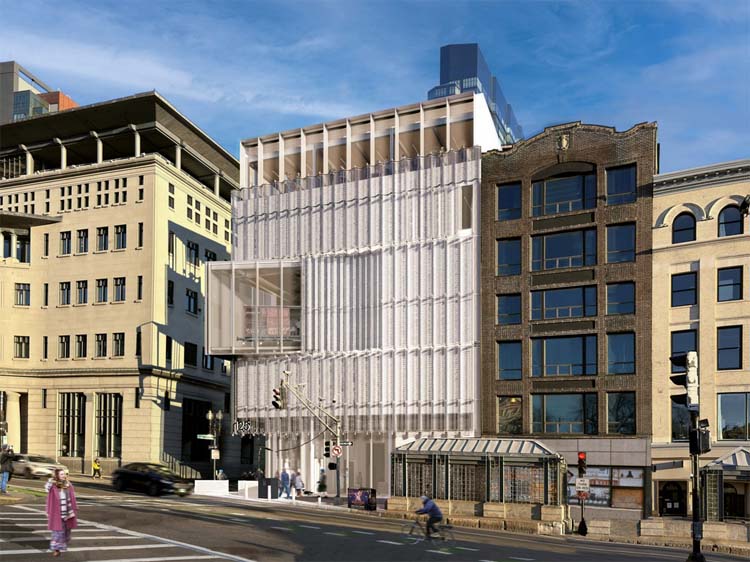
The proposed Holocaust Museum Boston on Tremont Street. PHOTO COURTESY SCHWARTZ/SILVER ARCHITECTS
The Holocaust Legacy Foundation has filed architectural renderings of the future Holocaust Museum and Education Center with Boston’s Planning and Development Agency. The Foundation aims to preserve and perpetuate the memory and lessons of the Holocaust for future generations.
The renderings provide a first look at the proposed design, showing a dramatic, inspiring, and hopeful building, constructed with durable, timeless materials. The six-story, 33,000-square-foot building will be located on Tremont Street along the Freedom Trail. The main feature of the exterior is a gently undulating stainless-steel woven metal fabric that wraps the building’s mid-level floors. The metal fabric evokes the curtains that remained drawn in Jewish households at the time of the Nazi rise to power, and the fences that surrounded the death camps and kept Jewish prisoners enslaved.
The curtain is pulled back to reveal a modern bay window that will house an authentic railcar used for the deportation of Jews to the extermination camps of the Third Reich. From the Freedom Trail, people may see museum visitors filing into the railcar but not exiting, illustrating the reality of millions of people who were transported to their deaths.
“From the street, spectators will witness the history of the Holocaust in the moment that freedom is lost,” said Jody Kipnis, who had the idea to expose the rail car. “This will serve as a powerful reminder of the dangers of allowing prejudice and hatred to go unchallenged.”
Kipnis and Todd Ruderman are the cofounders of the Holocaust Legacy Foundation.
The Holocaust Museum will tell the story of one of the most extreme examples of the consequences of unchecked hatred and bigotry. Museum goers will see the horrors that result from antisemitism, and the grave consequences of prejudice and discrimination. This confrontation can serve as a stark reminder of the dangers of allowing such ideologies to persist and motivate individuals to actively combat antisemitism and all hatred in their own lives and communities.
The design is the work of Boston architecture firm Schwartz/Silver Architects Inc. “We are honored to be a part of this extremely important and timely project for the City of Boston – and for all New England. Inspired by the idea that learning from our past will lead to a better future, the building will be made of honest, sustainable materials, and energy efficient mechanical systems. The recycled metal fabric curtain wrapping the facade will flicker in the afternoon sunlight and glow at dusk,” said Jonathan Traficonte, principal at Schwartz/Silver. “From the top floor multi-purpose and events room on Tremont Street, with its full-height glass windows, visitors will be reminded of the freedoms we enjoy, with views of the Boston Common, the Freedom Trail, and the State House.”
The museum will provide a cautionary experience. “The Holocaust Museum will emphasize the importance of embracing diversity and respecting human rights,” Kipnis said.
“Through the exhibitions, educational programs, and outreach initiatives, we intend to foster an understanding of the value of inclusivity, tolerance, and equality. By emphasizing the shared humanity of all people and the importance of safeguarding the rights of minority groups, we will encourage visitors to reject antisemitic beliefs and promote a more inclusive society.”
The museum is scheduled to open in early 2026.
